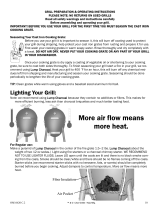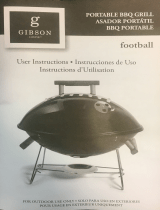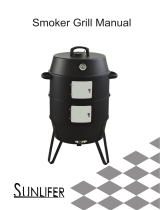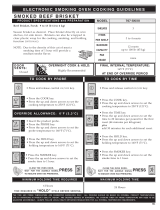
First Use
Beef Tips
Beef Brisket
Undoubtedly, the hardest piece of meat to cook for most people, whether they
are barbecuing it or cooking it in the kitchen on a stove. The key to this flavorful
and delicious piece of meat is cooking time…a ‗long‘ time!
The fibrous connective tissues (collagen) are tough and plentiful and need the
time and right heat in order to break down and render a nice tender final
product.
There are three types of Brisket available to the consumer: the Whole
Brisket (or ―Packer Trim‖), the Flat and the Point. The whole Brisket is
generally cheaper in price, but also has more fat, and weighs any where from
11 to 16 pounds, depending on the size of the cow that it came from.
The whole Brisket can be broken down in to the Flat cut and also the
Point cut. The Point cut is very fatty and not found very often in
stores, except for Corned Beef Brisket Point Cut. The Point, when
trimmed up and ground, makes a very nice hamburger for the grill. The
Flat is the most common seen at stores in the meat counter. This cut is
also popular for back yard chefs, as it doesn‘t take as long to cook as the Whole
Packer Trim. It‘s the cut used for most of the Corned Beef that you
see advertised around St. Patrick‘s Day.
Trim or not to trim before cooking? There are two schools of thought on
this. A few of the ‘old timers‘ season it with all the fat left on, cook it and
then trim the fat away when ready to serve. Also being thrown away is a
lot of the seasoning and outside ‗bark‘, which is one of the best parts of
the Brisket! We like to trim our Briskets down to about ¼‖ of fat, or less.
Some of the fat will cook away, but will leave a nice looking layer when
sliced for serving and presentation. And, the outside seasonings/bark gets
to go in your mouth and not the trash.
PREPARATION:
Trim your meat to about ¼‖ of fat. Completely season both sides with your
favorite BBQ rub or just plain Kosher Salt, pepper, garlic and paprika. Rub
it in with your fists, adding more seasoning if it looks like you need it.
Wrap the meat in plastic wrap and store in the refrigerator over night.
Set your grill up for indirect cooking at 250°F. Don‘t forget the drip pan, as
quite a bit of fat will be rendered out. About an inch of water in the pan will
prevent the fat from ‗burning‘ during the cooking process. For smoke, a
mix of hickory and cherry wood is excellent for Brisket. Oak is another fine
wood. Mesquite is also popular, but it can impart a harsh ‗smoke‘ flavor if
too much is added. I have found that Mesquite is an acquired taste, much
like Scotch whiskey.
24
Beef Brisket (continued)
Take the meat directly from the refrigerator and put it on the grill. You will
notice a small dip in the temperature gauge, but not to worry, your temp
should get back to normal within a few minutes. Cold meat seems to ‗take
on‘ smoke better than room temperature meat and it will give you a nice
―smoke ring‖, which is a coveted coup de gras for all barbecue cooks.
The general rule of thumb for barbecuing a Brisket is 1½ - 2 hours per
pound. The best suggestion is to use a probe type thermometer that will monitor
the internal temperature in the thickest part of the meat. This way there will be
no surprises when it‘s time to take it off the smoker.
The first couple of hours will find the temperature rising quite rapidly in the
meat. Around 150°F, or so, it will start to slow down and at about 165°F (+ or
-) the meat will be reaching the ―plateau‖ and may or may not stay in the\is
range for a couple of hours. The collagen is breaking down and it needs
this time to do it properly. Don‘t rush it, don‘t bump up the temperature
and don‘t get excited! Let it do it‘s thing.
When the Brisket gets to 185°F, you will want to start paying a little more
attention. For ―sliced Brisket‖ pull it from the grill at 190°F and for ―pulled
Brisket‖ let the temp get to 200°F. Whichever method you choose, you now
have another decision to make: foil or not to foil?
If you choose not to foil, pull the meat from the smoker to a platter and let
it ‗rest‘ for about 20 minutes and then slice thin against the grain for sliced
Brisket. For pulled Brisket, just cut the meat into chunks and then shred
with a couple of knives or your fingers.
Use the ―FTC‖ (foil, towel and cooler) technique for 30 minutes to an hour.
Double wrapping the meat in heavy duty aluminum foil, wrapping it again
in a plain old, but clean, kitchen or bath towel and then placing it into a
beverage cooler than has been preheated with a few cups of boiling
water. This allows the juices in the meat to redistribute completely, so
there won‘t be a pool of juices in one end of the meat. This is also a great
way to keep the meat warm for a few hours in case it got done quicker
than you planned on or if you want to transport it.
That‘s all there is to it!! Some folks like to prep their Brisket with plain
yellow mustard and them apply the rub. The mustard ‗disappears‘ during
the cooking and let‘s the seasoning create a ‗crust‘ of sorts. You will taste
NO mustard at all, just the rub that you put on. Others like to inject the
meat with liquid and seasonings, which allows more flavor to penetrate
the meat and also helps the meat to cooker quicker. Which ever method
you choose to use, the end result will be great.
First Use
19
























